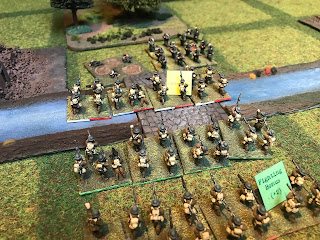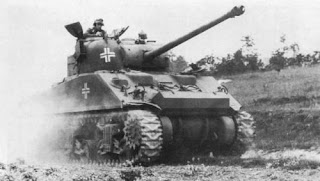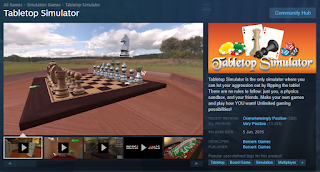The Rough Guide to Solo Wargaming
With the UK entering country-wide lockdown and many countries across Europe already under the same measures, this means there are a lot of gamers sitting twiddling their thumbs. So, I thought I'd write a guide to solo gaming, based on my own experience and games I've played successfully solo. This may be helpful and hopefully will give you a different view of what you can do with your time until the crisis passes.
There are many wargames that can easily be played as a solo experience. The most obvious point is that you will need to have two opposing sides to play them with. As many wargamers have several armies, this shouldn't be an issue. However, if you find that you do only have figures from a single side, an alternative is to proxy the figures for the enemy. Alternatively, set the game in a civil war or a rebellion. There are many instances in history when soldiers who had previously been fighting side by side turned their weapons on each other or captured equipment was used against its previous owners.
So, now we have the opposing sides, how do you actually go about solo gaming? In games that have no hidden movement rules and are of the IGOUGO style this is simple enough to set up the board, set up the opposing figures and move them as normal, but making the best move you can at that given time. If you treat each side as though it is the one under your command at that time, you will find that you play the game fairly and make the best of the move that you can.
There are some wargames that work better for solo gaming than others, for example, the Too Fat Lardies sets of rules usually have a randomised system of activation. This is with cards or dice and generally only one unit is activated at a time, rather than the entire army. The randomisation factor is perfect for solo gaming as it forces the player to think on their feet. As a solo player, you will be in a position to make decisions for that individual unit and ensure they are the best options at that particular time. The good thing about the Lardies games is that they are available in PDF form from their website. As are a lot of the things you will need to play the game, such as decks of cards, supplements and a whole host of other things, so you can get started straight away once you have printed off what you need. I have also produced three how to play video of the TFL's I Ain't Been Shot, Mum rules, which are perfect for solo gaming. Please watch part one here (links to the other parts are in the video description on Youtube):
So playing the game can be quite simple, but what about random events or hidden movement? Obviously in some games there may be ambush elements or surprises that the opposing player wouldn't know about. These issues can easily be solved by creating random event tables or a deck of cards which are activated when, say, a unit moves close to a building that may hold enemy troops. Simply roll on the table or draw a card and if the result shows there are soldiers hiding there, place them on the tabletop. If you treat each piece of scenery or building as a potential hiding place for enemy troops this will make your moves more cautious as you approach. This could be as simple as:
1D6:
1-3 = nothing
4 = sniper
5 = anti-tank gun
6 = infantry section
By adding more options and larger dice or a set of cards, the player can play a patrol type game where they are moving through the board, having to deal with each threat as they appear. Similarly, the same can be done for hidden movement tokens. If you are moving units about as hidden movement tokens, create a table that includes all your force options which you can roll on as the token is revealed. Obviously, if a unit is already on the board, just re-roll to get a different result or replace the result with unit that has not already been spotted. Admittedly, this is a slightly more random way of handling hidden movement, but by adding dummy tokens to the mix, you can still create the element of surprise. So a typical table could look like this:
1D6
1 = Dummy (three in total)
2 = One Infantry Section
3 = HQ Section
4 = AT Gun
5 = Tank company
6 = Mortar company
So in this table, if you only have one tank company, the next time you roll a 5, you could replace it with an infantry section. In the examples above, I have used typical Second World War units, but you could easily replace them with anything that you are using. A card activation system works even better for randomisation as you are not restricted to the faces of the dice. A deck can be created with each individual unit marked on the card face, or a normal deck of playing cards with the face value being replaced with specific gaming units. Once that card is drawn from the deck and the unit placed on the tabletop, the card can be removed, ensuring it isn't drawn again in future.
Alternatively, cards can be used to plot the opposing forces movements. There are some games, such as Wings of Glory, where players have created a set of movement cards for the opposition which react to the player's movement. This will take a little bit of work, but could be as simple as: 'move forward until contact with enemy, then attack' or 'hold position, finding best cover within 12"' Each card is dealt out to the enemy units and revealed when it is that unit's time to act.
Alternatively, cards can be used to plot the opposing forces movements. There are some games, such as Wings of Glory, where players have created a set of movement cards for the opposition which react to the player's movement. This will take a little bit of work, but could be as simple as: 'move forward until contact with enemy, then attack' or 'hold position, finding best cover within 12"' Each card is dealt out to the enemy units and revealed when it is that unit's time to act.
On the other hand, if you don't have access to a table, scenery and even many miniatures, there are other avenues you can explore. Virtual gaming is a big thing, with many platforms allowing players to either play games solo or against an opponent on the internet. One of the more attractive is Tabletop Simulator, which can be bought through Steam. The interface takes a bit of getting used to, but there are many player created armies and games in the 'workshop' section. Simply search for the one you are after, download it and you're ready to play. I have just done a quick search and found the following Warhammer 40K, Star Wars: Legion, Blucher, Chain of Command, Flames of War and Bolt Action armies and scenarios on there (click the links). There are many more that I haven't explored myself.
Alternately, there are the free platforms such as Vassal, which although it is less attractive than TTS has a large amount of user-created games that can be played either solo or with an opponent through the chat system. For both Vassal and TTS there are plenty of tutorial videos on Youtube to get you up and running quickly.
And finally, we are in the golden age of board games and there are many modern games that are designed specifically for solo play. Some of my favourites are made by Fantasy Flight Games, such as the Arkham Horror series of card games and board games and the Lord of the Rings Living Card Game. I have a couple of videos showing you how some of these game play below, please check them out. Many other board games also have solo options, such as Agricola, have a look on Board Game Geek and search specifically for solo games there. Mostly, games that are billed as co-operative can easily be played solo, such as Pandemic, This War of Mine, Gloohaven, etc, by playing the game as normal, but making the choice alone, rather than as a group.
OK, so that covers quite a few examples of how you can play solo just by changing a few things around and thinking outside the box. I'm happy to discuss things further in the comments below, so please leave a message if there is something I've not covered or information that you can pass on. If you've never solo gamed before, give it a try, as you play, you will develop your own rules and aspects to keep the game flowing. Most importantly, remember to have fun and keep yourself safe!
I have also made a video about this subject, if it is easier to listen to me talking than reading, then please watch it here:
I have also made a video about this subject, if it is easier to listen to me talking than reading, then please watch it here:
All Amazon links are affiliate links and I get paid a small amount if any purchases are made through them.





As you possibly know, I have done solo rules for both Wings of Glory and X-Wing https://herkybird.tynesidewargames.co.uk/wofg.html
ReplyDeletehttps://herkybird.tynesidewargames.co.uk/x-wing.html
And Sails of Glory...
https://herkybird.tynesidewargames.co.uk/sailsofglory.html
Thanks for that, I did link to your site for the Wings of Glory Solo cards, but the other links are very helpful!
DeleteNice, I think a lot of us may feel doing this, although my wife is willing to learn simple games like Wings if War and Star Wars, and perhaps a odd skirmish gladiator game.
ReplyDeleteCheers
Matt
It's worth a try, it can be a lot of fun and a different gaming experience. Get her started on the gateway stuff then drop a full blown Napoleonic Italian Alps campaign on her.
DeleteI really enjoyed your blog posts, thank you.
ReplyDelete